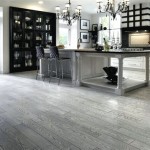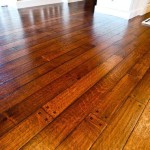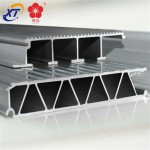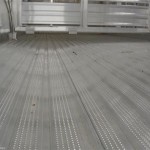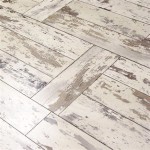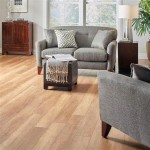Homebase Vinyl Wood Flooring: A Comprehensive Guide
Homebase offers a diverse range of vinyl wood flooring, providing homeowners with a durable, aesthetically pleasing, and cost-effective alternative to traditional hardwood. This article delves into the characteristics, benefits, installation, maintenance, and considerations associated with Homebase vinyl wood flooring, offering a comprehensive overview for potential buyers.
Vinyl flooring, also known as resilient flooring, has evolved significantly over the years. Modern vinyl wood flooring convincingly replicates the look and feel of real wood, thanks to advancements in printing and texturing technologies. Homebase leverages these advancements to provide a selection of vinyl options that mimic various wood species, finishes, and plank sizes.
The composition of vinyl wood flooring typically involves multiple layers. A wear layer on the surface protects against scratches, stains, and fading. Below the wear layer is a printed design layer, which provides the realistic wood appearance. Layers of core material, often made of PVC or other composites, provide stability and water resistance. A backing layer offers cushioning and helps to reduce noise transmission.
Understanding the Benefits of Homebase Vinyl Wood Flooring
One of the primary advantages of vinyl wood flooring is its water resistance. Unlike natural wood, which can warp, swell, or rot when exposed to moisture, vinyl is impervious to water. This makes it suitable for installation in bathrooms, kitchens, and basements—areas where traditional wood flooring is often unsuitable. Homebase vinyl flooring options are designed to withstand spills, splashes, and humidity, making them practical choices for moisture-prone environments.
Durability is another key benefit. The wear layer on vinyl flooring protects it from everyday wear and tear, making it resistant to scratches, dents, and scuffs. High-traffic areas, such as hallways and living rooms, benefit significantly from the resilience of vinyl. Homebase offers vinyl flooring with varying wear layer thicknesses, allowing customers to choose the appropriate level of protection based on their specific needs and the anticipated volume of foot traffic.
Compared to hardwood, vinyl wood flooring is generally more affordable. The lower cost of materials and manufacturing translates into a more budget-friendly flooring option for homeowners. The installation process can also be simpler and less expensive than installing hardwood, particularly with click-lock vinyl planks that can be installed without glue or nails.
Maintenance of vinyl wood flooring is straightforward. Regular sweeping or vacuuming removes loose dirt and debris. A damp mop with a mild detergent is sufficient for cleaning spills and stains. Harsh chemicals or abrasive cleaners should be avoided, as they can damage the wear layer. With proper care, Homebase vinyl wood flooring can maintain its appearance for many years.
The availability of design versatility is a significant draw for many consumers. Homebase offers a wide array of vinyl wood flooring styles, colors, and plank sizes. This allows homeowners to create a variety of looks, from rustic and traditional to modern and contemporary. The ability to mimic different wood species, such as oak, maple, and walnut, without the cost and maintenance associated with real wood, makes vinyl an appealing option for those seeking a specific aesthetic.
Installation Considerations for Homebase Vinyl Wood Flooring
Proper subfloor preparation is essential for a successful vinyl flooring installation. The subfloor must be clean, level, and dry. Any imperfections, such as cracks or unevenness, should be addressed before laying the vinyl. Homebase typically recommends using a self-leveling compound to create a smooth surface if necessary. A clean subfloor ensures proper adhesion and prevents the vinyl from conforming to any irregularities, which can lead to premature wear or damage.
The installation method depends on the type of vinyl flooring. Some vinyl flooring comes in sheet form, which requires adhesive and precise cutting. Others are available as planks or tiles with a click-lock system, which allows for a floating installation. Floating installations are generally easier for DIYers, as they do not require glue or nails. However, it is important to follow the manufacturer's instructions carefully to ensure a secure and stable installation.
Acclimation is another crucial step. Vinyl flooring should be allowed to acclimate to the room's temperature and humidity for at least 48 hours before installation. This helps to prevent expansion or contraction after installation, which can cause gaps or buckling. The recommended acclimation period may vary depending on the specific product and environmental conditions, so it is important to consult the manufacturer's guidelines.
When installing vinyl flooring around existing fixtures, such as toilets or cabinets, precise cutting and fitting are necessary. Using a utility knife and a straightedge, carefully cut the vinyl to fit around the fixtures, leaving a small expansion gap. This gap can be covered with trim or molding to create a finished look. Accuracy in cutting and fitting ensures a professional-looking installation and prevents water from seeping under the flooring.
For larger rooms or complex layouts, it may be advisable to hire a professional installer. An experienced installer has the tools and expertise to ensure a proper and long-lasting installation. While DIY installation can save money upfront, a professional installation can prevent costly mistakes and ensure that the flooring performs as intended over the long term.
Maintaining and Caring for Your Homebase Vinyl Wood Flooring
Regular sweeping or vacuuming helps to remove dirt, dust, and debris that can scratch or dull the surface of the vinyl flooring. Using a soft-bristled broom or a vacuum cleaner with a floor brush attachment is recommended. Avoid using vacuum cleaners with beater bars, as they can damage the wear layer. Frequent cleaning prevents the buildup of abrasive particles that can gradually wear down the flooring.
For cleaning spills and stains, use a damp mop with a mild detergent. Avoid using excessive water, as it can seep into the seams and damage the subfloor. Wring out the mop thoroughly to ensure that it is only slightly damp. A neutral pH cleaner is generally recommended, as acidic or alkaline cleaners can damage the finish. Always follow the manufacturer's recommendations for cleaning products and procedures.
Avoid using abrasive cleaners, scouring pads, or steel wool, as these can scratch the surface of the vinyl flooring. Similarly, avoid using solvent-based cleaners or wax polishes, as they can leave a dull or sticky residue. For stubborn stains, try using a diluted solution of baking soda and water or a specialized vinyl floor cleaner. Always test the cleaner in an inconspicuous area before applying it to the entire floor.
Protect your vinyl flooring from heavy furniture by using felt pads under the legs of tables, chairs, and sofas. These pads prevent scratches and dents when furniture is moved. Avoid dragging heavy objects across the floor, as this can also cause damage. Using furniture coasters under heavy appliances can further protect the flooring from indentations.
Minimize exposure to direct sunlight, as prolonged exposure can cause the vinyl flooring to fade over time. Use curtains, blinds, or window film to reduce the amount of sunlight entering the room. Regularly rearranging furniture can also help to prevent uneven fading.
Although vinyl flooring is water resistant, it is important to clean up spills promptly to prevent staining. Absorb the spill with a clean cloth or paper towel, and then clean the area with a damp mop and mild detergent. Pay particular attention to spills that contain acidic substances, such as juice or vinegar, as these can potentially damage the finish if left unattended.
By following these maintenance tips, homeowners can ensure that their Homebase vinyl wood flooring remains in good condition for many years, providing a durable and attractive flooring solution.
Ultimately, selecting Homebase vinyl wood flooring involves careful consideration of aesthetic preferences, budget constraints, and practical needs. By understanding the benefits, installation requirements, and maintenance procedures outlined above, potential buyers are equipped to make informed decisions that align with their specific circumstances.

Brady Vinyl Flooring Oak Plank Effect 2x3m Homebase

Cross Wood Vinyl Floor Tiles 305 X 305mm 1sqm Pack Homebase

Laminate Vinyl Wood New Lower On Flooring Tiling Homebase

Krono Original 8mm Herringbone Laminate Flooring Homebase

Laminate Vinyl Wood New Lower On Flooring Tiling Homebase

Rigid Core Luxury Vinyl Flooring Natural Oak Herringbone Homebase

Laminate Vinyl Wood New Lower On Flooring Tiling Homebase

Rigid Core Spc Luxury Vinyl Flooring Light Oak Coastal Sand Plank Homebase

20 Off Selected Flooring Laminated To Vinyl Homebase

Rigid Core Spc Luxury Vinyl Flooring Coastal Light Grey Plank Homebase
Related Posts

